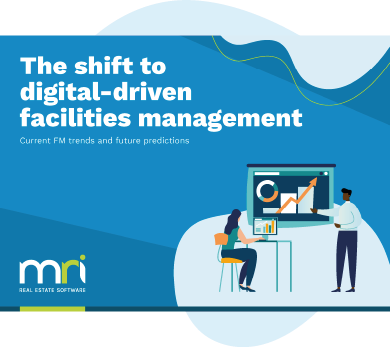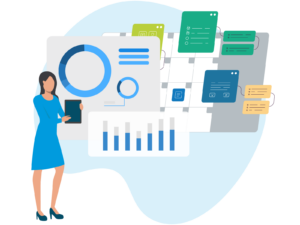Why is facilities management software so important?
Sometimes, you can’t beat a classic. A book may unlock your imagination more than the film. You might get more pleasure out of a board game than the latest console blockbuster.
But this analogy shouldn’t extend to your approach to facilities management software.
Over time, the development of this technology has empowered FM teams and the organizations they work in to operate more efficiently, more intelligently and more seamlessly, while making fewer mistakes and saving money over time.
Yet, despite this, some companies haven’t opened their eyes to this software, and continue to persist with traditional, archaic approaches to facilities management. Companies that are missing out on the incredible advantages this software unlocks over past techniques.
If you’re still in the dark, here we shed some light on 5 key areas where facilities management software offers a considerable, crucial edge over bygone approaches:
Productivity
The Traditional Problem
No matter the size or industry of an organization, a productive workforce is essential to success. This is particularly true for their FM team – their influence on how seamlessly buildings operate makes it critical that they can fulfill their duties speedily and successfully.
Traditional, manual approaches to FM restrict this significantly. Due to the breadth of responsibilities on today’s FM teams, a non-automated approach to creating, distributing and check-off tasks immediately adds a lot more time and effort to their day.
And, if FMs can’t be at their most productive, then this can lead to an ever-expanding list of tasks and issues, that if not resolved, could then impact the happiness and productivity of the wider workforce.
The Software Solution
Facilities management software adds that layer of automation that enables FMs to generate and direct tasks to their teams with ease. By greatly reducing the time it takes for these to be produced, performed and verified, it means engineers have more capacity throughout their day to fulfill more obligations, while not feeling in any way overworked.
Plus, as traditional FM practices were not as all-encompassing as software solutions like MRI Evolution, it meant that FM teams would have growing paper trails of tasks to keep track of, taking even more time to organize. By encapsulating everything in a single platform, teams have the information they need to work as productively as possible.
Finally, FM software can give engineers a steer of what tasks are most urgent at any moment in time, enabling them to apply their attention to where it’s needed most at any given time.
64% of British workers believe they could fit their day’s work into a shorter span of time (Ginger Research)
Accuracy
The Traditional Problem
Speaking of long-winded paper trails, the traditional approach to FM could be the cause of accuracy issues. Files are misplaced. Folders are lost. Assets change and people forget to update their spreadsheets. All become more likely when you increase the opportunity for human error.
With data driving the direction of organizations today like never before, as well as ever-tightening regulations on data protection to comply with, inaccuracies can not only lead to ineffective maintenance regimes, unnecessary expense and poor business strategies, but it can cause companies to be penalized for lack of compliance.
The Software Solution
By eliminating a lot of the human factor and containing all critical asset and business data in one easy-to-digest solution, facilities management software empowers teams with more accurate information that they can harness to streamline their operations and propel their company forward.
Furthermore, with the capacity to update data in real-time rather than have to rely on finding the right spreadsheet or file and making the change manually, FM software helps to ensure that information is up-to-date at all times.
35% of FM software purchasers say keeping accurate records is the biggest challenge they face with their existing approach (Team Support)
Proactivity
The Traditional Problem
Traditional approaches to facilities management were typically reactive in nature. While it’s impossible to plan for every maintenance or cleaning issue that arises in a building from day to day, having a universally reactive approach to managing a site is problematic for several reasons:
- Unscheduled downtime can be incredibly costly for a company, covering both costs to repair, time wasted, and potential hits to your reputation
- If engineers are regularly pulled away from their schedules for unplanned tasks, this hurts their efficiency and could lead to jobs being missed
- Only performing maintenance or repairs on assets when something goes wrong can significantly reduce their operational lifespan
The Software Solution
One of the most important advantages that facilities management software has supported is FM teams’ ability to cement effective PPM schedules. By containing all relevant asset specifications and information, teams can plan well in advance when components need maintenance work done, rather than rely on a “wait and see” approach.
Schedules are clearer and less likely to be altered. Lifecycles of assets are extended significantly. Any need for downtime can be planned accordingly to cause a minimum of disruption.
Over time, the proactive approach propelled by CAFM software can result in significant time and cost savings for organizations, utilizing strategies that get the most out of their assets and future-proof their facilities.
The cost of unplanned downtime can cost industrial plants anywhere up to £185,000 per hour (Aberdeen Group)
Wellness
The Traditional Problem
Outdated attitudes to facilities management were primarily focused on the delivery of building services. While this is undoubtedly a crucial element in FM, it misses out the critical “people” element of this industry. At the end of the day, facilities management is as much (if not more) about looking after the people on site as it is about looking after the physical building itself.
The impact of COVID-19 has heightened this need even further. With increased awareness on the cleaning measures an organization puts in place, the way they manage space, and how they make working environments as comfortable and secure as possible, FMs need to place a greater emphasis on wellness than in previous generations.
An emphasis that traditional, “building-first” approaches to facilities management can’t fulfill.
The Software Solution
The functionality of modern facilities management software is much more capable of supporting the wellness and happiness of employees, occupants and others. By making builders smarter and empowering people with the ability to influence their working environments for their own benefit, today’s software prioritizes people in a way old systems couldn’t:
- Harness the Internet of Things (IoT) to capture information from various rooms and spaces and use this to automatically adjust temperature, humidity, lighting and more to create optimal working conditions
- Provide mobile workforce applications that allow team members to highlight any issues they spot on site to the relevant personnel
- More streamlined, effortless communication between FMs and engineers throughout the site to make life easier for all involved
An estimated 1.3 million people in 2015/16 suffered from illnesses caused by or made worse by being at the workplace (Health and Safety Executive)
Flexibility
The Traditional Problem
Another COVID-driven influence that would have proved problematic for traditional FM practices is the move towards remote working. With traditional approaches tightly tied on-site hardware and resources, the move to working from home would have come as a major culture shock for organizations still employing these techniques.
Furthermore, the old-school approach to facilities management would leave little room to maneuver with respect to collaboration and scalability, particularly in a post-COVID landscape.
Without a dedicated, digital means to communicate with colleagues efficiently, and the capacity to readily expand a system’s function when required, these issues could significantly hamper productivity and lead to much grander costs if upgrades were required to meet new demands.
The Software Solution
A cloud-based, facilities management software solution like MRI Evolution gives organizations a much greater degree of flexibility than past approaches.
The ability to access all information digitally from any location, on desktops or mobile devices, means that everyone can access the data, schedules, projects and more they need at any point in time. This flexibility enables people to work in the most productive manner possible, and means there is no risk of the flow breaking down in times of remote working.
There is no question that companies experienced with FM software were in a stronger position to pivot their approach in-line with COVID-19 requirements. The flexibility, adaptability and collaborative nature of these platforms are head-and-shoulders above what FM could aspire even 10-15 years ago.
88% of companies globally made it mandatory for (or encouraged) employees to work from home in response to the COVID pandemic (Gartner)
Feel The Value of Facilities Management Software
This is just a sample of the significance that facilities management software carries in the industry today.
As the list of responsibilities and requirements for FM teams continues to grow with each passing year, software that can both make these easier to manage and give them greater influence in a better and brighter future for their business is a powerful asset.
MRI Software has been at the forefront of this technology for over 30 years, and we are constantly evolving and refining our comprehensive MRI Evolution platform to meet the ever-changing landscape that FMs must contend with. We always consider how we can support organizations right now and in the future, and this ensures that our software is geared to make businesses run better.
Better productivity. Better accuracy. Better proactiveness. Better wellness. Better flexibility.
Discover the ultimate FM solution today – speak to our team.
The shift to digital-driven Facilities Management
Introduction Historically, the success of the FM function was measured by its ability to keep things running behind the scenes. With new and urgent industry challenges bringing facilities management into the limelight, this is no longer the case. Fac…

